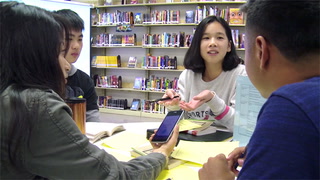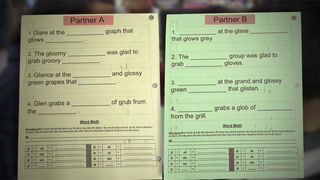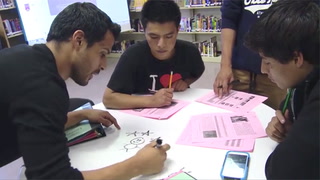Preparing for Literature Circles with a Jigsaw Transcript
Speaker 1: Make sure that your books are open 106.
So in order for all of my students from the class to be confident and prepared for literature circle discussions, I do a modification on a jigsaw by having students work in role-alike groups to prepare their reading roles before they return for their literature circle discussions.
It says you're going to be the illustrator, and then, everybody else, you should follow this list right here.
Students: [crosstalk 00:00:32]
Speaker 1: My students are in heterogeneous reading groups, and in those groups, they read texts together, and they discuss the text.
Here's the roles you'll do this time.
Every week, they have a different reading role.
If you're going to be the discussion director, come sit at this table. If you're going to be the illustrator, sit at Abu Bakr's table.
Students: [crosstalk 00:00:51]
Speaker 1: Before they come to their literature circle discussion, but after they've read, they split up with other students from the class that are working on the same reading role.
Find your new seat quickly, please.
It helps them prepare, ask questions, and feel confident about what they're going to say before they come back to their home groups to then have a discussion with students who have all done different reading roles.
Students: [crosstalk 00:01:14]
Speaker 3: What did he do on this job?
Speaker 4: Deliver presents.
Male Student: Gift, gift.
Speaker 6: Yeah, gift for people.
Speaker 1: When we look for keywords, what are we looking for? They have to do two things. Keywords connect to what?
Male Student: To this chapter.
Speaker 1: They connect to the chapter and what else?
Female Student: Of the chapter and important events.
Male Student: It's interesting for you.
Speaker 1: Those two things.
Students: [crosstalk 00:01:38]
Speaker 1: Illustrators, you guys know what to do.
Male Student: Also, when he-
Students: [crosstalk 00:01:43]
Speaker 1: It's also really useful for maximizing my ability to help students, because I can go to the table, and I can talk with discussion directors, and I can talk with the discussion director at all four groups in 30 seconds, as opposed to going from table to table to table answering the same question four times.
I want you for that last question to try to make one that connects to something else that you've learned about.
Students: [crosstalk 00:02:05]
Speaker 1: I came to structure it this way through trial and error. Originally, I just had the discussion directors like, "Okay, all discussion directors, come to this table, and we can work together there," and that improved the quality of their work a lot. And so I thought it might work for all of the other roles as well, and so I started breaking students up that way, based on what I was seeing in their work.
Emily, will you make sure that you have that question, too, about human nature?
Male Student: Can you repeat again, what does-
Emily: What does Francisco's action when he gives the money to his family tell us about human nature?
Students: [crosstalk 00:02:31]
Speaker 1: The summary group is almost finished. The illustrators are almost finished. What if we take one more minute?
Students: [crosstalk 00:02:43]
Emily: You should put the names.
Female Student: This one? This is Miss-
Emily: Yeah.
Students: [crosstalk 00:02:43]
Female Student: Nelson?
Male Student: Nelson.
Speaker 1: Please return back to your original reading group.
I think this is an especially supportive structure for English learners, because whenever they're asked to produce language for their peers in sort of a performance, like these discussions and literature circles are, the less their effective filter is up and the more they're able to use the cognitive skills that they have.
You can begin.
Female Student: How can you connect it to human nature?
Students: [crosstalk 00:03:06]
Speaker 1: So this gives students an opportunity to really feel confident in what they have to say, so that those barriers can fall to the side, and they can just shine and show what they know.
















20 Comments
Kassandra Amaya Oct 15, 2023 1:12pm
A) It helps prepare them for the literacy circles. Each person is assigned a different role in the group and it gets switched up every class. Each group reads the text and gains information which they can take back with them to their literacy circle. This also builds their confidence to ask questions and discuss with their peers.
B) It is a great strategy for ELLs because it allows them to learn how to communicate and discuss with others for practice before going back to original group and enter a more deep convsersation about the text.
C) The way i would improve this would probably put at least one best english speakers in a group as a leader so that help with the flow of conversation.
Evelyne Vittoz Nov 25, 2018 6:45am
The video is great but most pdf in the resources are unavailable, my browser issues a security warning for most of them. :(
Anne Swigard Jun 30, 2018 3:54pm
Robert Novak Jun 5, 2018 10:28am
Ebrahim Ebrahim... Jun 1, 2018 5:23pm